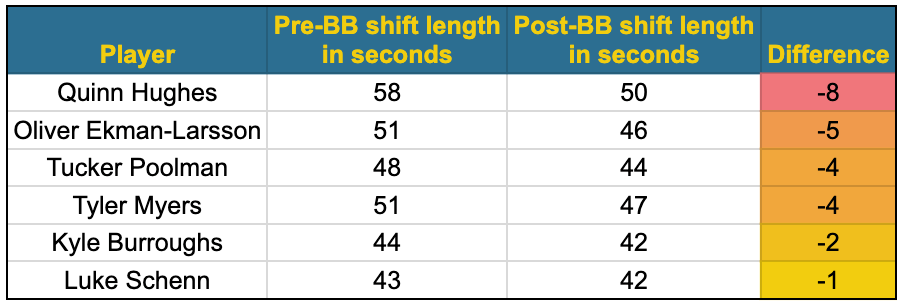Ever since he got to Vancouver, Bruce Boudreau has emphasized the importance of short shifts.
On Tuesday before the Vancouver Canucks game against the Florida Panthers, Boudreau said the team has adjusted very well to his demand for short shifts.
“I think it’s the only way we can play, quite frankly,” said Boudreau. “As a matter of fact, over nine games, [the Canucks are] probably better than any team I’ve ever coached on the short shifts.”
Just how short have the Canucks’ shifts been? Has it been a noticeable difference compared to before the coaching change?
Well, yes and no. There’s a little bit of nuance here.
Canucks' average shift length has dropped since the coaching change
Prior to the coaching change, the Canucks average shift length was 45.1 seconds, which is right around league average — maybe slightly below. After the coaching change, the Canucks’ average shift length went down to 43.8 seconds — a small difference but a difference nonetheless.
Where it gets interesting, however, is the split between forwards and defence.
The average length of shifts for forwards was 43.2 seconds under Travis Green and 43.0 seconds under Boudreau. That’s barely a difference at all.
There was some movement among individual players. Elias Pettersson’s shifts shortened the most among Canucks forwards — he was previously averaging the longest shifts among the forwards at 50.0 seconds per shift, tied with Brock Boeser — but those shorter shifts were balanced out by longer shifts for the likes of Vasily Podkolzin and Jason Dickinson and most of the team’s forwards barely saw their shift length change at all.
The defencemen, however, have had shorter shifts across the board. Every single Canucks defencemen has had shorter shifts under Boudreau than they did under Green.
Quinn Hughes has seen the biggest drop in shift length
The biggest change has been for Quinn Hughes. Prior to the coaching change, his average shift length was 58 seconds — nearly a full minute.
That was likely a reflection of long shifts on the power play, as well as extended shifts when the team was pushing for goals while trailing, but there may have been an element of coaching philosophy there as well. Perhaps defence coach Nolan Baumgartner saw no issue putting his best defenceman out on the ice for such long shifts, particularly with his smooth skating, which he makes look so effortless.
Since the coaching change, Hughes’ average shift length has dropped by eight seconds to 50 seconds. That’s a pretty significant difference, even if is still the longest shift length on the Canucks.

At the same time, Hughes’ overall ice time has gone up, to the point that he’s averaging 25:30 per game, which would put him up among the league leaders in ice time per game, above the likes of Aaron Ekblad, Drew Doughty, Devon Toews, and Victor Hedman.
In other words, Hughes is taking shorter shifts but he’s taking a lot more of them. Hughes was averaging 25 shifts per game before the coaching change and is averaging around 30 shifts per game now.
Boudreau suggested that for a smaller, high-energy guy like Hughes, short shifts are ideal, allowing him to play at a higher pace. It makes sense: Boudreau’s approach to the game is all about playing at a high tempo and constantly pushing north. For a player playing that many minutes, it does make sense to tackle hose minutes in smaller bursts of energy.
"You can't play an up-style tempo if you have long shifts."
Luke Schenn explained what playing Boudreau’s system means for a defenceman.
“There's no question that Bruce wants an up-style tempo, which involves forechecking, it involves D getting up in the play, it involved having good gaps in the neutral zone,” said Schenn. “At the end of the day, all the game is is skating and being in the right position. If you don't do it, you get yourself in trouble and it's noticeable as an individual and collectively as a team.”
“When you're not skating and moving your legs with the puck or without the puck is when you're in trouble,” he added. “If you get caught sitting back, that's not the recipe at all.”
According to Schenn, that’s why short shifts are so important.
“You can't play an up-style tempo if you have long shifts,” he said. “I mean, you can do it for 20-30 seconds in a shift but once you get past 45-50 seconds into a minute, it's impossible to play that up-style tempo because the other team's probably taking short shifts, and it's tough to keep up.”
Schenn definitely practices that: his average shift length is shortest among Canucks defencemen since the coaching change at 42 seconds, despite frequently playing with Hughes. His shifts were shortest before the coaching change as well, though that was generally in a third-pairing role at the time.
"If they're taking shorter shifts, it's because we're in a position to do it."
Shift lengths have dropped for the Canucks’ other top-four defencemen as well, by five seconds for Oliver Ekman-Larsson and four seconds for Tyler Myers.
Those differences seem significant for the Canucks’ defence but Boudreau himself suggested some caution in taking those numbers too much to heart.
“If they're taking shorter shifts, it's because we're in a position to do it,” said Boudreau. “We get the puck deeper and we're not trapped in our own zone for a minute, minute-and-a-half at a time. And those are the shifts that really bring up your ice times.”
With that in mind, there is a chicken-or-the-egg question: are shorter shifts helping the Canucks have more success or is the Canucks’ success allowing the defence to take shorter shifts?
At the very least, it’s an interesting trend to keep an eye on as the season progresses.



